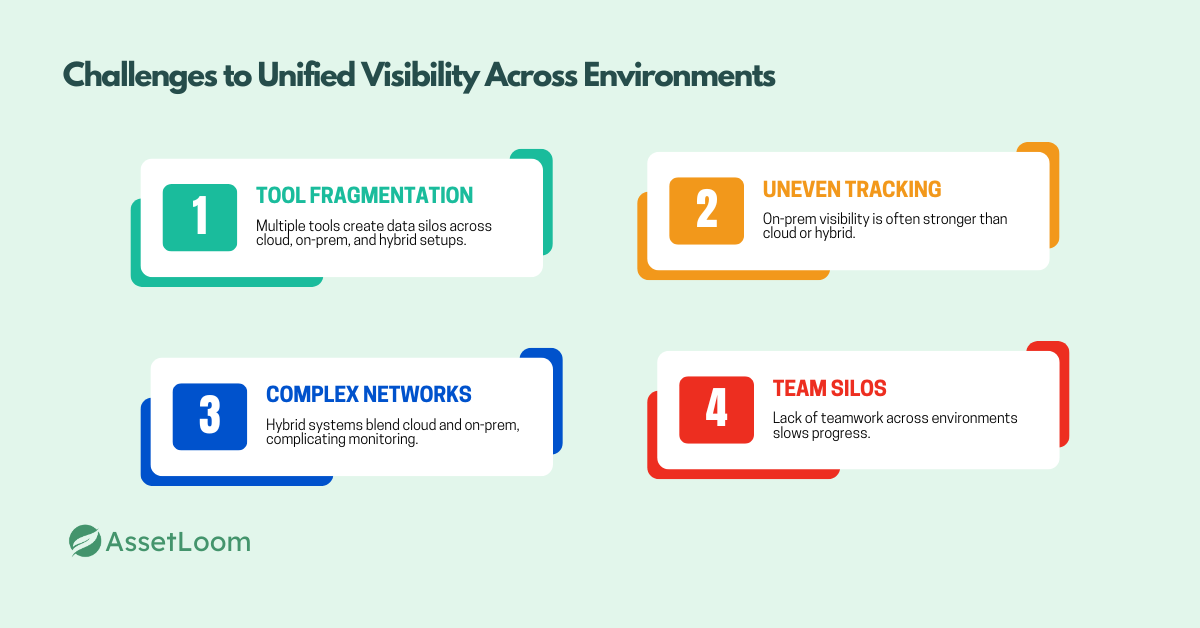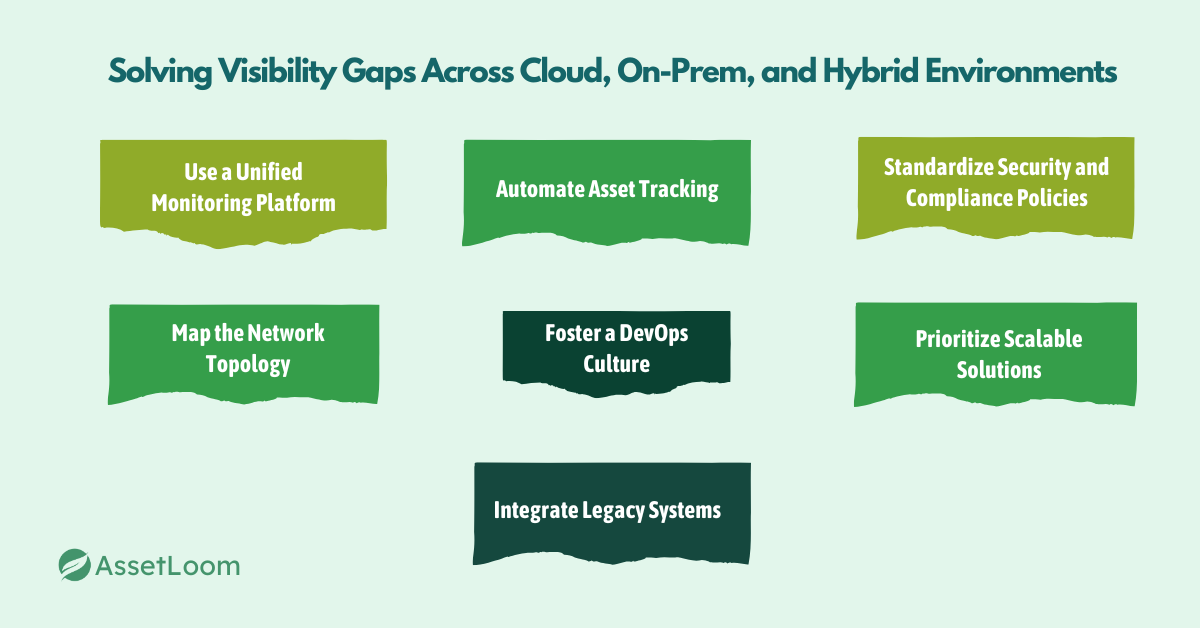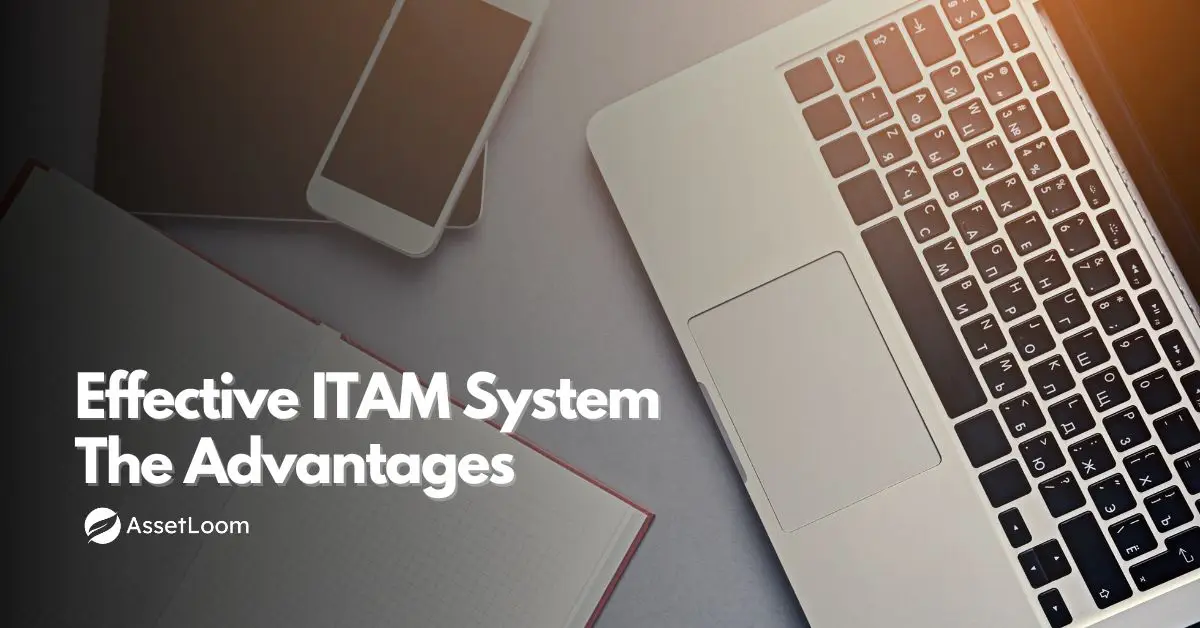Solving Visibility Gaps Across Cloud, On-Prem, and Hybrid Environments
Solving Visibility Gaps Across Cloud, On-Prem, and Hybrid Environments: Learn how to tackle blind spots in IT asset management with practical strategies and tools.
Visibility Gaps Across Cloud, On-Prem, and Hybrid Environments are blind spots where organizations lose track of their IT resources, like unmonitored cloud instances, forgotten on-prem servers, or mismatched hybrid integrations. With lots of IT leaders using hybrid cloud setups, these gaps are more common than ever, creating risks and inefficiencies. This blog is your guide to understanding why these gaps happen, why they matter, and how to tackle them strategically across cloud, on-prem, and hybrid environments.
Visibility gaps can lead to wasted budgets, security headaches, or compliance slip-ups. Whether it’s an untracked AWS instance or an outdated server lurking in a data center, these blind spots make IT management feel like herding cats. We’ll explore their causes, impacts, and practical solutions; without drowning you in techy details. By the end, you’ll see how to bring clarity to your IT landscape, no matter how complex.
What Are Visibility Gaps and Why Do They Exist in Cloud, On-Prem, and Hybrid Environments?
Visibility gaps are blind spots where businesses lose track of IT assets in cloud, on-prem, and hybrid environments. These gaps, like untracked cloud apps, outdated on-prem servers, or disconnected hybrid systems, lead to inefficiencies, security risks, and compliance issues. They make managing IT feel like a constant guessing game.
Why do these gaps happen? In cloud environments, fast growth and shadow IT (like employees using unapproved apps) create hidden resources. Many businesses track on-prem systems well, with clear views of servers and hardware, but struggle to see enough data in the cloud. For on-prem environments, manual tracking of hardware or software often falls behind, leaving old records.
Hybrid environments face challenges because cloud and on-prem tools don’t always work together. Using multiple tools creates data silos, hiding the full picture of IT assets. Key causes include:
- Too many tools: Disconnected systems across cloud, on-prem, and hybrid setups miss critical data.
- Uneven tracking: Strong on-prem visibility doesn’t carry over to cloud or hybrid systems.
- Complex setups: Hybrid networks mix cloud and on-prem, making tracking tough.
- Hidden assets: Unapproved shadow IT sneaks through in any environment.
These gaps are like cooking without a full recipe. Understanding their causes helps businesses take control across all three environments.
Why Is Visibility Crucial Across IT Environments?
So, Visibility across cloud, on-prem, and hybrid environments means knowing exactly what’s happening with your IT assets at all times. Without it, businesses risk wasting money, missing security threats, or failing compliance checks. It’s like having a clear dashboard to steer your IT operations smoothly.
In cloud environments, untracked apps or servers pile up expenses, like paying for software nobody uses. For on-prem systems, missing data about hardware can cause unexpected downtime, halting work. In hybrid setups, disconnected cloud and on-prem systems slow down operations, making workflows clunky.
Security takes a hit when gaps hide vulnerabilities. Unmonitored cloud apps or outdated on-prem servers can become easy targets for hackers, as seen in past cloud breaches. Compliance suffers too, as untracked assets lead to missing records, risking fines for regulations like GDPR. The impacts include:
- Cloud operations: Wasted money on unused resources.
- On-prem operations: Downtime from untracked hardware.
- Hybrid operations: Slow workflows due to poor integration.
- Security risks: Hidden vulnerabilities in any environment.
- Compliance issues: Missing data for audits or regulations.
Visibility isn’t just nice to have; it’s the backbone of smart IT decisions. Without it, managing cloud, on-prem, and hybrid environments feels like driving blindfolded.
Challenges to Unified Visibility Across Environments
Achieving unified visibility across cloud, on-prem, and hybrid environments is tough because IT setups are complex and often disconnected. These challenges create visibility gaps that make it hard to track assets, spot issues, or stay secure. Businesses face hurdles that turn IT asset management into a tricky puzzle.
One big issue is tool fragmentation. Many companies use different tools for cloud, on-prem, and hybrid systems, leading to data silos that hide key information. Another problem is uneven tracking, where on-prem systems are easier to monitor than cloud or hybrid setups. Hybrid environments are especially tough, as they mix cloud and on-prem systems that don’t always play nice together.
Old on-prem tools often struggle to keep up with modern cloud systems, creating gaps. Teams working separately on cloud, on-prem, or hybrid assets also make coordination tricky. Key challenges include:

- Tool fragmentation: Multiple tools create data silos across cloud, on-prem, and hybrid setups.
- Uneven tracking: On-prem visibility is often stronger than cloud or hybrid.
- Complex networks: Hybrid systems blend cloud and on-prem, complicating monitoring.
- Team silos: Lack of teamwork across environments slows progress.
These hurdles are like juggling too many balls at once. Overcoming them requires a smart, unified approach to IT management.
Strategic Approaches and Principles to Solve Visibility Gaps Across Cloud, On-Prem, and Hybrid Environments
Closing visibility gaps in cloud, on-prem, and hybrid environments means creating a clear, unified view of all IT assets. These gaps, like untracked cloud apps or outdated on-prem servers, lead to costly mistakes, security risks, and compliance issues. The strategies below offer practical ways to bring clarity to your IT landscape, ensuring smoother operations across all environments.
1. Use a Unified Monitoring Platform
A unified monitoring platform pulls data from cloud, on-prem, and hybrid systems into one place. Instead of using separate tools that create data silos, this approach gives a complete picture of assets, like cloud instances or on-prem hardware. It simplifies tracking and reduces blind spots. Businesses can see everything, from a new cloud app to a hybrid data flow, in one view. This clarity saves time and helps spot issues early.
2. Automate Asset Tracking
Automation is key to keeping up with fast-changing cloud environments and complex hybrid setups. Manual tracking misses new assets, like unapproved cloud apps or forgotten on-prem devices. Automated tools discover these assets in real time and flag issues, like an unused server costing money. This reduces human errors and keeps visibility tight across all environments. It’s like having a tireless assistant watching your IT 24/7.
3. Standardize Security and Compliance Policies
Consistent security and compliance policies close gaps that hackers or auditors might exploit. Different rules across cloud, on-prem, and hybrid systems create vulnerabilities or audit failures. Using the same access controls and tracking standards everywhere ensures no asset is overlooked. This approach strengthens security against threats and keeps compliance requirements, like GDPR, in check. It’s a simple way to stay safe and audit-ready.
4. Map the Network Topology
Mapping the network topology tackles the complexity of hybrid environments. By visualizing how cloud and on-prem systems connect, businesses can spot hidden gaps, like unmonitored network segments. Regular checks of this map keep visibility strong as hybrid setups grow. This ensures no part of the network is left in the dark. It’s especially helpful for catching issues in mixed environments.
5. Foster a DevOps Culture
A DevOps culture encourages teamwork across cloud, on-prem, and hybrid teams to share data and insights. Siloed teams create gaps when they don’t coordinate, like missing a cloud app update. Practices like continuous monitoring bring everyone together, ensuring a unified view. This collaboration keeps visibility strong throughout the IT lifecycle. It’s like getting all players on the same team.
6. Prioritize Scalable Solutions
Scalable solutions ensure visibility keeps pace as businesses grow. New cloud services, upgraded on-prem hardware, or expanded hybrid setups can outgrow old tools. Flexible platforms adapt to these changes, maintaining clear tracking in cloud, on-prem, and hybrid environments. This prevents new gaps from forming as IT evolves. Scalability is essential for long-term success.
7. Integrate Legacy Systems
Connecting legacy systems with modern tools closes gaps in on-prem environments. Older systems often don’t work well with cloud or hybrid setups, leaving assets untracked. Integration platforms or system updates bring these into the fold, ensuring full visibility. This bridges the gap between old and new technology. It keeps every asset visible, no matter how old.
Shorten, these strategies work best when treated as principles, not one-time fixes. Businesses should:

- Use a unified platform: Combine cloud, on-prem, and hybrid data into one view for clarity.
- Automate tracking: Discover assets and issues in real time to reduce errors.
- Standardize policies: Apply consistent security and compliance rules across all environments.
- Map networks: Visualize hybrid connections to eliminate blind spots.
- Promote teamwork: Adopt a DevOps culture for better collaboration across teams.
- Prioritize scalability: Choose tools that grow with cloud, on-prem, and hybrid needs.
- Integrate legacy systems: Connect old on-prem tools with modern cloud solutions.
- Optimize costs: Use visibility to cut waste and improve efficiency.
Finally, managing visibility across cloud, on-prem, and hybrid environments is like keeping a garden tidy: it takes steady effort, but the results are worth it. Track success by checking how quickly issues are found (mean time to detect) and fixed (mean time to resolve). Fewer gaps and smoother operations show these strategies work.
Tool You Can Try To Unified Visibility Across Environments
Tools that tackle visibility gaps in cloud, on-prem, and hybrid environments help businesses track IT assets clearly. They pull data together, reducing risks, costs, and compliance issues. Think of them as flashlights for your IT setup.
IT asset management (ITAM) platforms, like those from AssetLoom, track cloud apps, on-prem servers, and hybrid systems in one view. They cut through data silos for a clear picture. Cloud management tools focus on cloud and hybrid setups, spotting unused resources or integration snags.
Network monitoring tools map hybrid connections, catching gaps in cloud and on-prem links. Observability platforms use smart analytics for real-time insights across all environments. Key benefits include:
- Unified view: Combine cloud, on-prem, and hybrid data.
- Fast issue detection: Spot problems quickly.
- Better security and compliance: Keep assets audit-ready.
These tools, including solutions like AssetLoom, make managing cloud, on-prem, and hybrid environments simpler and safer. It’s like having the right tools for a sturdy IT toolbox.
Final Thoughts
Addressing visibility gaps in cloud, on-prem, and hybrid environments is an ongoing journey, not a one-time task. These gaps, like untracked apps or disconnected systems, can disrupt operations, security, and compliance if left unchecked. Regular effort keeps your IT landscape clear and under control.
Cloud systems add new apps daily, on-prem setups change with hardware updates, and hybrid integrations shift constantly. Evolving compliance rules and team changes make continuous tracking essential. Using unified tools and teamwork, as explored earlier, helps close these gaps for good.
Start small, check one cloud app or on-prem server to spot hidden issues. Solutions like AssetLoom’s resources can guide you toward better visibility without complexity. It’s like tending a garden: steady care keeps cloud, on-prem, and hybrid environments thriving, secure, and efficient.

Subscribe for Expert Tips and Updates
Receive the latest news from AssetLoom, right in your inbox.


